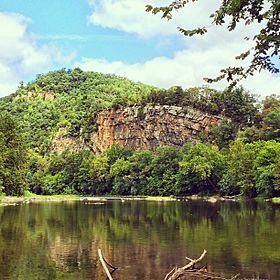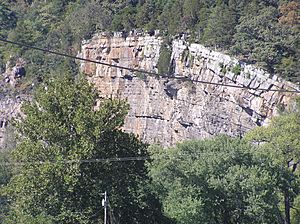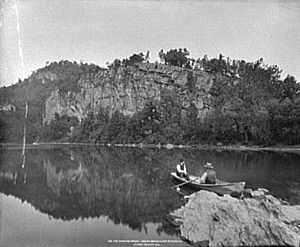Hanging Rocks facts for kids
Quick facts for kids Hanging Rocks |
|
|---|---|

Hanging Rocks viewed from the South Branch Potomac River
|
|
| Elevation | 1,040 ft (317 m) |
| Location | Hampshire County, West Virginia, United States |
| Range | Mill Creek Mountain Ridge and Valley Appalachians |
| Coordinates | 39°23′56″N 78°44′21″W / 39.399°N 78.7391°W |
| Topo map | USGS Springfield |
Hanging Rocks are tall, straight cliffs that rise almost 300 feet (about 91 meters) above the South Branch Potomac River. You can find them in Hampshire County, West Virginia, in the United States. These amazing rocks are located about four miles (6 km) north of Romney near Wappocomo, right on West Virginia Route 28.
Throughout history, Hanging Rocks has also been called Painted Rocks and Blue's Rocks. Sometimes, people call them Upper Hanging Rocks to tell them apart from the "Lower Hanging Rocks" found further north along the South Branch at Blues Beach.
Contents
Geology: How Hanging Rocks Formed
Hanging Rocks is made up of three large, arch-shaped rock folds. Geologists call these folds "anticlines." The rocks here are made of layers of sandstone and limestone. The top layers are a type of sandstone. Below that, you'll find a layer of cherty limestone, which is a type of rock with small pieces of brachiopods (ancient sea creatures) inside. On top of Hanging Rocks, there's a flat area with rich soil and no stones.
At the western end of Hanging Rocks, there are layers of dark shale rock. These shale layers contain small round lumps called concretions and some fossils. One of these shale layers has many fossils of a creature called Phacops cristata. Other fossils found here include different types of ancient sea shells.

The Hanging Rocks formation sits in a deep, narrow gap in Mill Creek Mountain. This gap was created by the South Branch Potomac River. The river slowly cut its way through the mountain as the mountain formed, revealing the impressive Hanging Rocks. The gap at Hanging Rocks is about five-eighths of a mile long.
This gap is one of four gaps in Mill Creek Mountain. The others are Mechanicsburg Gap, the Lower Hanging Rocks gap at Blue Beach, and another gap where the North Branch Potomac River meets the South Branch.
History: Stories of Hanging Rocks
Native American Presence
A Battle Long Ago
Hanging Rocks was once the site of a Native American village. It was likely home to either the Delaware or Seneca people. This area was also the scene of a fierce battle between the Delaware and Catawba tribes. A group of Delawares had taken prisoners from the Catawbas and were heading home. They stopped at Hanging Rocks to fish in the South Branch River.
The Catawbas, who were chasing them, found the Delawares. They sent groups of warriors to surround the Delawares from the front and back. A very bloody battle followed, and many Delaware warriors died. It's believed that only a few Delawares managed to escape.
Ancient Discoveries
In the 1830s, people found a row of Native American graves between the road and the cliffs along the South Branch. These graves might have belonged to those who died in the battle mentioned above. Later, in the 1880s, when the Baltimore and Ohio Railroad was being built, workers found human bones, possibly from these graves.
On a farm across the river from Hanging Rocks, people found skeletons of "gigantic size." This suggests there was a large Native American village and burial site there. Besides skeletons, they also found old fireplaces, iron hatchets, glass beads, and brass ornaments.
Some people believe the Native Americans living in this village were part of the Seneca tribe. There used to be many stone mounds (piles of stones) along the hillside behind this village. These mounds were different sizes, from two to eight feet high. Inside some of them, people found old bones. Very few other items were found in the mounds, but one contained a pipe carved with a wolf's head.
European Settlement
European settlers began to arrive in the area around Hanging Rocks in the mid-1700s. Before they arrived, the trees had already been cleared from the rocks. Early settlers called Hanging Rocks "Painted Rocks" because of the colorful patterns and shapes in the rock layers. These colors were not made by Native Americans, but by natural geological processes, like water seeping through the rock.
During the French and Indian War, two small forts were built near Hanging Rocks to protect the South Branch Valley. These were Fort Williams (built in 1754) and Fort Foreman.
Francis Asbury, an early bishop of the Methodist Episcopal Church, traveled through the South Branch Valley in 1781. He described it as a place of "mountains and natural curiosities." In his journal, he wrote about Hanging Rocks:
On my way to R. Williams' I had a view of a hanging rock that appears like a castle wall, about three hundred feet high, and looks as if it had been built with square slate stones; at first glance a traveller would be ready to fear it would fall on him.
Transportation Routes
A wagon road called the Moorefield and North Branch Turnpike (later the North and South Branches Turnpike) used to run between the South Branch River and Hanging Rocks. This road connected Romney and Cumberland, Maryland. The Baltimore and Ohio Railroad (now the South Branch Valley Railroad) was later built in this same narrow space, which is only about 40 to 100 feet wide. The railroad reached Romney in 1884.
The old turnpike eventually became West Virginia Route 28. However, Route 28 was later moved to the east of Mill Creek Mountain. The original road at the base of Hanging Rocks is now called West Virginia Secondary Route 28/15, or Harriott-Wappocomo Road.
American Civil War
Hanging Rocks was an important location during the American Civil War. On June 19, 1861, Captain John Q. Winfield wrote from his camp at Hanging Rocks, mentioning that the area was home to wealthy and welcoming families. Their large plantations were nearby, including Ridgedale and Wappocomo. General Turner Ashby and his troops also stayed at Ridgedale, north of Hanging Rocks.
Battle of Hanging Rocks Pass
A small but important fight, known as the Battle of Hanging Rocks Pass, happened here on September 24, 1861. It was between the Confederate Hampshire Militia, led by Colonel Angus William McDonald, and some Union troops.
On the evening of September 23, Colonel McDonald learned that Union forces planned to pass through the gap at Hanging Rocks the next morning. So, McDonald and 26 of his men climbed to the top of Hanging Rocks before dawn on September 24. They got ready for the Union troops to arrive.
Hanging Rocks was a key spot during the Civil War. Soldiers traveling between Romney and places like Cumberland and Green Spring often used the road at the base of the cliffs. Also, the South Branch River was shallow enough at Hanging Rocks to cross, creating another connection to the Northwestern Turnpike at Mechanicsburg.
Once at the top, McDonald and his men gathered boulders at the edge of the cliffs. Their plan was to throw these rocks down onto the Union troops marching on the road below. They finished their preparations by daybreak. McDonald told his men to be careful not to mistake their own scouting party, who were returning, for the enemy.
Soon after daybreak, Union cavalry (soldiers on horseback) crossed the river and marched onto the road below the Confederates. At first, the Confederates lay flat, trying to see through the fog if it was their own scouting party. The Union troops were suspicious of this strategic location and were on high alert. They noticed the heads of the Confederate militiamen peering over the cliffs and fired at them.
The Confederates responded by throwing the boulders onto the road. This caused the Union cavalry to quickly retreat back down the road and across the river. In their rush, some cavalry riders ran over their own infantrymen (foot soldiers), forcing them into the river. At least five Union soldiers drowned.
Sergeant H. B. Hedge of the Union cavalry wrote in his journal about the event:
On the morning of the 24th, we had our first fight of any real importance, at what is called the Hanging Rocks, eight miles from Romney. Just about daylight we crossed the river, encountered their pickets and drove them back; but to our surprise, their forces were on the rocks overhanging the road, and they opened a heavy fire on us. The Lieutenant Colonel in command of the column gave no orders whatever; all was confusion; we were afraid to go forward, and could not get back, as our teams had come across the river and blocked the narrow passage between the rocks and the stream.
Fortunately for us, the enemy did not know we were so demoralized, and after a few volleys, retreated. Captain Keys kept cool, rallied his men, and after the enemy ceased firing, marched back over the river. Our loss was very slight, as the enemy fired over our heads. Our casualties were mostly in the river among some of the infantrymen, who in attempting to swim to the other shore, came into range of the enemy's fire.
After the fight, about a dozen Union soldiers' bodies were buried in the sand on the riverbank. High water a few days later washed more bodies down the river, which were also recovered and buried. The Confederates didn't know that the Union troops were actually retreating when they arrived at Hanging Rocks. After the skirmish, the Confederates left the gap and went back to Romney.
Poetry: The Hanging Rocks in Verse
Hanging Rocks inspired a poem called "The Hanging Rocks." It was published in 1836 in a book by John C. Newman.
GOD of nature! how tremendous
Does this mass of rocks appear?
How they hang–a work stupendous–
Balanc'd in the yielding air!
What detains them in their bases,
With the pond'rous part above?
Will they not start from their places?
See! their tops begin to move!
Be not frightened;–'tis the motion
Of the clouds beneath the sky;
They are trav'lling to the ocean,
Or to get a fresh supply.
They will bring a wat'ry treasure,
And the face of things renew;
Man, look on these scenes with pleasure;
Rocks and clouds were form'd for you!


